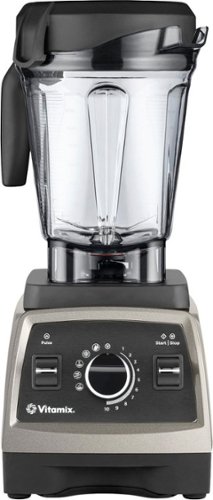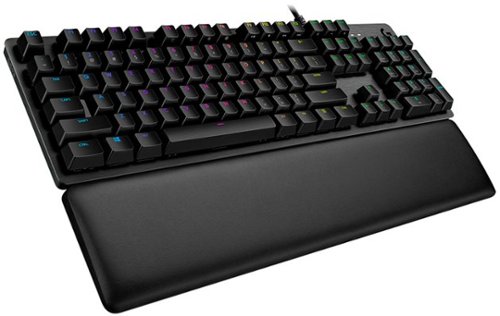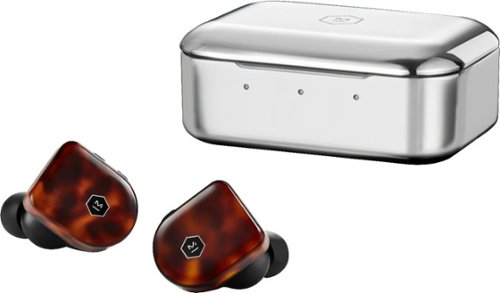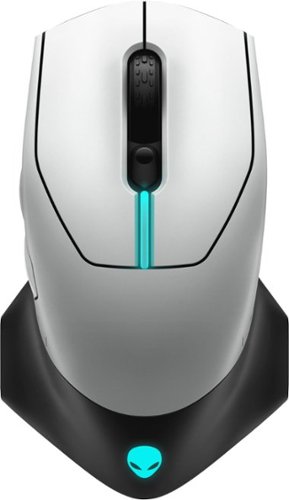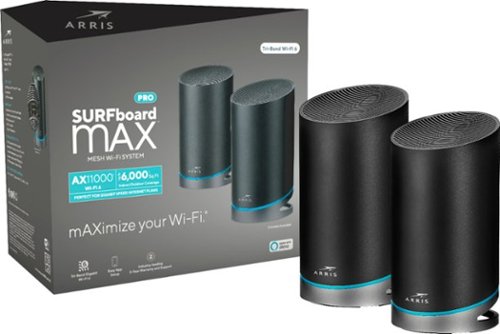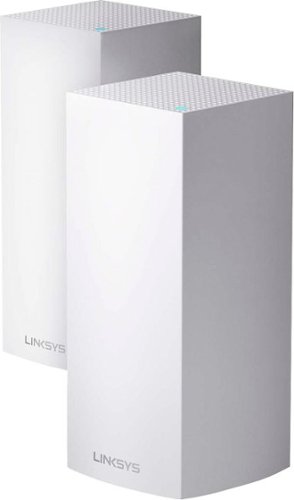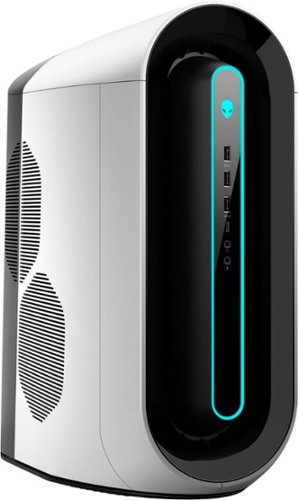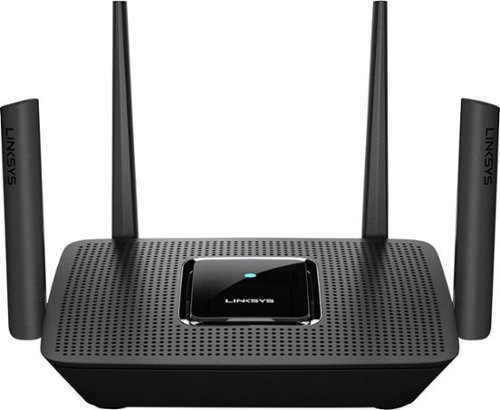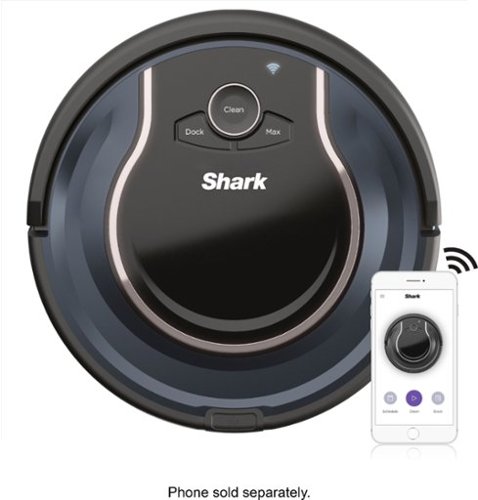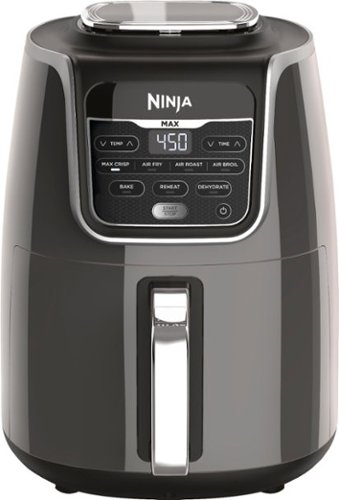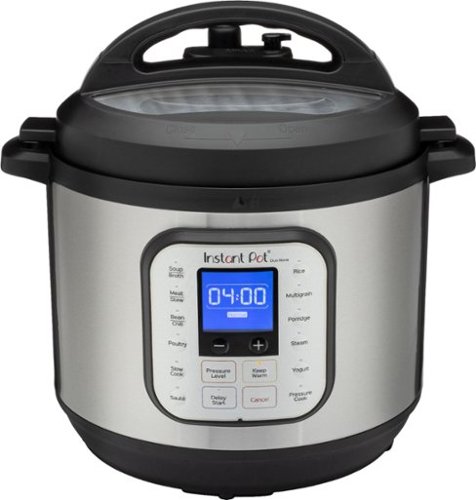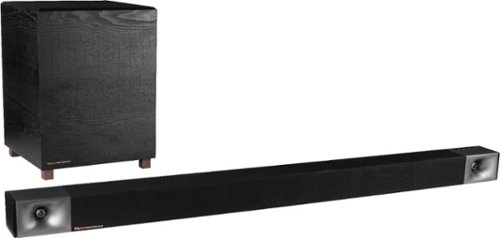Pilgrim007's stats
- Review count47
- Helpfulness votes197
- First reviewFebruary 25, 2010
- Last reviewNovember 3, 2023
- Featured reviews0
- Average rating4.6
Reviews comments
- Review comment count0
- Helpfulness votes0
- First review commentNone
- Last review commentNone
- Featured review comments0
Questions
- Question count0
- Helpfulness votes0
- First questionNone
- Last questionNone
- Featured questions0
- Answer count2
- Helpfulness votes0
- First answerJune 11, 2019
- Last answerOctober 15, 2020
- Featured answers0
- Best answers0
Five pre-programmed settings automatically handle Smoothies, Hot Soups, Frozen Desserts, Purées, and Self-Cleaning. The sleek exterior is highly durable and will complement any kitchen décor.
Posted by: Pilgrim007
from Oregon
Having previously used the cheaper blenders, I finally opted to try a Vitamix blender after hearing they are supposedly the best. My previous blender had gone the way of its predecessors, developing cracks in the pitcher and starting to gradually leak.
This blender had a 64 oz. pitcher but it is designed to be low profile and still fits under our cabinets when sat on top of the motor unit. This is a nice feature and saves us stashing it in a cabinet at knee-level which we had to do with the previous blenders.
The motor unit is well built and apparently the motor itself is a couple of horsepower. This is pretty amazing as some mowers aren't that much more powerful. The motor unit has a rubber cover over the surface that the pitcher sits on which likely helps protect it from any liquid spills. From reading the manual, I think the rubber cover is removable for deep cleaning.
The blades look fairly conventional and are an integral part of the pitcher - they are not removable. Marked with a "W", the blades I have are for working with wet products but you can apparently buy other pitchers and containers that have different functions. I would assume that the ones with a blade marked "D" are for grinding coffee or spices.
The blender also comes with a large recipe book (although half of it is the French version) and a plastic stick for pushing ingredients down nearer the blades while chopping - I have not needed to use that yet but it is specially designed for the pitcher and will stop before it gets to the blades.
So far I have used the blender for lots of smoothies (our main purpose) and making my own curry paste which I do every couple of weeks. The blender has 10 manual speeds as well as several pre-set programs that will cover most things you would want to use it for. The first preset is smoothie and runs for about 45 seconds.
I don't know if I would say this is quieter for making smoothies than my last blender but it certainly has a more pleasant tone. It cuts up about 99% of the ingredients I put in which is certainly more than I am used to - often I would find entire spinach leaves that had not been cut and were just stuck to the side of the pitcher - with this blender, I might find the odd piece of cut spinach but not enough to worry about.
The blend is very good and you certainly won't find any chewy bits after the blades are finished. We tend to follow the standard instructions for adding ingredients (liquid, powders, leafy vegetables, frozen) in that order and have no problems so far.
For the curry paste, I used to cut up the ingredients more than the recipe demanded because I had little confidence in the blender. With the Vitaxmix, there is no such lack of confidence and it handily chops what I throw at it - half onions, ginger pieces, shallots etc. My last blender had about 3 pairs of blades on a column which should have been enough but somehow wasn't. The Vitamix just has a conventional cluster of blades at the bottom but they are so powerful, they still out perform what I had before.
One piece of advice is to follow the manufacturer's instructions and not put any parts in the dishwasher. It's a bit inconvenient but I think the pitcher and blades may last longer. It could explain why all my other pitchers developed cracks but only time will confirm this. The Vitamix does have a cleaning function though where you add a drop of dish soap, half fill it with water, put the lid on and then run through each of the 10 speed settings in about 30-60 seconds. Once that is finished, you can rinse it out and it does tend to clean the inside very well. You still need to take care of the spout which is probably my least favorite feature - it's a bit drip-happy in my opinion but nothing to get too upset about.
All in all, this is a very good blender and although I have only scratched the surface with what it is capable of, it looks and acts tough and should have no problems keeping up with the jobs I use it for. I hope the pitcher lasts longer than the other models I have used up to now and I am confident this blender will last me many good years.
Mobile Submission: False
I would recommend this to a friend!
G513 is a high performance RGB mechanical gaming keyboard that features advanced technologies in a modern and sleek design. G513 includes full spectrum ~16.8M color RGB per key lighting with LIGHTSYNC technology, choice of mechanical switches, and a memory foam palmrest to deliver utmost comfort. G513 is the perfect blend of performance, advanced technologies and features, and unparalleled build quality and comfort.
Posted by: Pilgrim007
from Oregon
I was excited to try this new keyboard from Logitech and I have to say, it did not disappoint.
It looks amazing, has great keystrokes and is a huge improvement on the OEM, wireless keyboard I replaced it with.
You hook the keyboard up via a 6 foot, fairly heavy duty cable that has two USB connectors - one is for the keyboard and its power needs and the other is for a USB pass through which I will talk about later in this review.
To really get the most out of it, you want to download the Logitech G Hub software which allows you to configure the lighting. It is amazing just how programmable each key is, whether individually or as part of a series of keys that interactively light up on demand. I stuck with a couple of the pre-set combinations but love that they can be configured per game or application. For instance, my current favorite thing is that when Spotify is running, the keys default to dark and then light up and look like a pulsing equalizer waveform bar, in synch with the music which looks very cool!
Logitech says you have control over each key, for animation as well as the color and can pick from 16.8 million colors. I haven't tried much of this but when I did experiment briefly, it looked like you really could do this.
You can set up different combinations per app or game as well as program your own macros for the 12 function keys. This is all handled in the G Hub software. I have not tried it yet but playing a shooter game in the dark, you could have the keys default to black and then light up in the appropriate color when you shoot etc.
The G Hub software had preset lighting patterns that other users had created and you could download from a library. The caveat was you needed to set up an account which I have not done yet but some of the patterns looked good.
I really liked having the USB pass through. There is a port on the back of the keyboard and you can connect anything there and not have to fiddle about on the computer, looking for an open port. I used mine at the weekend to program a remote control and it was nice to just stay sat on the couch and connect up there.
I have my keyboard connected to a USB hub and 12' extension cable and have no problems at all. The response time in games is excellent and I have no complaints on the smoothness of the keys or keeping up with what is happening on the screen.
The memory foam palm rest that comes with the keyboard is nice but detached, so is not something I use a great deal, due to how I play sat on a couch with the keyboard in my lap. For desktop players, it would be much better.
The keyboard is fairly heavy, with a lot of aluminum in the case and much different to the cheap, plastic keyboards you become used to. I like this one so much, I might try to get a second one to use just for work - the keystrokes are that smooth!
All in all, this is a wonderful keyboard and definitely makes you wonder what you have missed all the years you didn't own one!
Mobile Submission: False
I would recommend this to a friend!
Hear your music clearly with these tortoiseshell Master & Dynamic true wireless earphones. Custom beryllium drivers provide sharp, expansive sound, and the high-quality antenna quickly pairs with compatible Bluetooth devices and offers a 20m range for freedom of movement. These water-resistant Master & Dynamic true wireless earphones include a stainless steel charging case that holds three charges for up to 14 hours of listening time.
Customer Rating

5
Surprisingly Good Bass in a Small Package
on December 27, 2019
Posted by: Pilgrim007
from Oregon
This is my second set of Master & Dynamic headphones (I also have the over-ear MW65G1) so I was expecting quality. These MW07 Plus True Wireless noise canceling in-ear Headphones certainly don't disappoint.
The manufacturer's and Best Buy's write-ups cover the technical aspects so I will concentrate on how I found them and what I liked or did not like.
First they ship with a charging cable (USB-C), a shiny, stainless steel carry/charging case and different size ear buds and wings, in case the default size attached does not work for your ear size. It also has squeeze-opening, soft carry case which the buds alone as well as the steel case will fit in.
The steel case will get fingerprints and scratches on it so I won't get too attached to it's out-of-the-box state. Still, it looks good and is quite functional, including three charging lights to show the charge of each bud individually, as well as the case itself. The buds will charge when put back in the case but eventually the case needs charging back up too.
I tried the ear phones with the default wings and rubber buds and they were ok but I felt they would fall out if I did anything too active. The bass response was ok but I felt like I needed to push them in to my ears more to get the best response. I later changed the buds and wings out for the next size up which made a lot of difference. They now seem like they will stay in if I run or workout with the on as well as providing a much better response across all audio ranges, especially the bass.
The control are small but work well to change volume, turn noise cancelling on or off, connect to Siri or another assistant or cue up tracks. I find the earbuds very easy to just throw on and be listening to music in a few seconds which is great for my jaunts across the campus I work on. Other models I have would be too clumsy or take too long to get unpacked and set up so this has been a great new feature for me to use daily rather than in my downtime at home.
The earbuds look unusual in the tortoise shell but I like the look of them and it is nice that you can also get them in other colors if that doesn't work for you.
Compared directly against my MW65G1, I was surprised at how similar in sound quality they were. The over-ear are obviously better but not drastically and both had similar audio performance when tried them with the same tracks. I have not directly compared with the two other sets of earbuds I have but going off memory, I think these are much better and will likely use them instead of the other two from now on.
I think these are a good looking, great sounding set of very convenient earbuds with great audio response!
Mobile Submission: False
I would recommend this to a friend!



Make every shot count in a firestorm with this Dell Alienware dual-mode gaming mouse. The rechargeable LiIon battery provides up to 350 hours of gaming, and the detachable 6.5-foot cable offers flexible connectivity. This Dell Alienware dual-mode gaming mouse features a 16,000 dpi optical sensor for fast, pinpoint accuracy in the battlefield, while the seven programmable buttons let you customize commonly used commands.
Posted by: Pilgrim007
from Oregon
I have never owned a mouse designed specifically for gaming so this was a new experience. I'm very pleased with the AW610M from Alienware and it was worth the wait.
The mouse matches my Alienware tower PC although I would still have been interested if I did not have the color-matched computer. It is possible to synchronize the color effects on both the mouse and the tower if you have the Alienware Command Center installed. I opted to have them both fade in out with red lights, like a "Red Alert" on a submarine.
The mouse itself is very comfortable and I particularly like the fins that hang off the back. They provide lots of support for my wrist which is usually the first place I notice aching after a long-ish gaming session. The mouse is wide enough not to feel cramp from gripping for long periods but still moves quickly enough to use for gaming.
I liked that I have the choice of using it wired or wireless. I have not noticed any speed issues running it on my preferred setup of wireless. I use the included dongle and just plugged it in the front of my tower but Dell recommends using the included extension cable and USB adapter to get a better connection.
The mouse has a built-in rechargeable battery and you can recharge it with the included USB cable that connects to a recessed port in the front of the mouse. There is a button behind the scroll wheel that switches between the various DPI options and also lights up to show when the battery needs recharging. You can also see in the Command Center app which lists the percentage of power left in the mouse settings.
You can customize up to seven buttons to specific games if you open up the Alienware Command Center and take the time to configure the mouse there. It is possible to tie these to specific games so it switches settings and colors on the computer and/or mouse (if set) when the game starts up.
The mouse has a button underneath for setting scroll speed as well as the aforementioned button to switch between the various DPI modes for mouse tracking resolution. As you click through, the button's colors change so that blue is 800 dpi, green (default) is 1600, yellow is 3500, orange is 9000 and red is 16,000 dpi. This is nice to be able to do on the fly, rather than hunt through software settings. It also makes it more convenient to adjust sensitivity from game to game.
The rechargeable battery supposedly lasts up to 350 hours which is impressive. I have yet to push it that much but so far, it appears to be economical with power consumed.
The mouse is very tactile and I find it ergonomic as well. It feels good to use for gaming and I have no complaints on the comfort level.
All in all, this is an impressive input device and certainly one I enjoy using on a daily basis. It makes for an attractive and highly functional gaming mouse and I look forward to customizing it as I add more games to my library.
Mobile Submission: False
I would recommend this to a friend!

Increase your data capacity to handle all your home network needs with this ARRIS SURFboard mAX Pro Wi-Fi system. The latest Wi-Fi technology, 802.11ax, delivers faster speeds and a wider range to accommodate more users, while the quad-core processors support high-bandwidth applications like simultaneous 4K streaming. This Alexa-compatible ARRIS SURFboard mAX Pro Wi-Fi system features four Ethernet ports for flexible connectivity to WAN networks.
Posted by: Pilgrim007
from Oregon
The ARRIS SURFboard mAX Pro AX11000 Wi-Fi 6 system has an eye catching design but I found it a little clumsy for routing wires.
Once you have your Ethernet cables and power connected, I suppose it is ok but if you need to unplug or plug again, you literally have to pick the unit up, flip it upside down and then remember to route the cable above the built-in stand and not below it. I’ve certainly seen simpler ways of routing Ethernet cables into these routers but again, this is a unique and fun design and there has to be a trade-off.
I was hoping for one more Ethernet port on each router – 1x WAN and 3X LAN is not ungenerous but my main router location has need for 1X WAN and 4x LAN (a couple of switches and a couple of direct runs to rooms). It’s not a deal breaker as you can easily run another switch in between but I have seen other Wi-Fi 6 routers that have this capacity.
The two units that ship in the box are identical except one will be the master and the second will cover another part of the house and be a node. They both have reset buttons if you ever need to start again which are activated with a paper clip underneath, while the power is on and after about 12 seconds, they reset and show a different light pattern on the band that runs around.
Using the SURFboard mAX app on an iPhone, I was able to set up my master router very quickly and easily. Within the app, you can name your network and the location of the router so you can differentiate it from the second unit when that is set up. The setup wizard will also make sure that if there is a firmware update out there, it downloads and installs this before you start to use the mesh network. This was a very quick update and the unit also restarted itself as part of the process without much assistance from me.
Using the SURFboard mAX app on an iPhone, I was able to set up my master router very quickly and easily. Within the app, you can name your network and the location of the router so you can differentiate it from the second unit when that is set up. The setup wizard will also make sure that if there is a firmware update out there, it downloads and installs this before you start to use the mesh network. This was a very quick update and the unit also restarted itself as part of the process without much assistance from me.
The second unit setup was fairly smooth. The app setup wizard offers to setup other nodes you may have (I had one more in this two pack) which I set up on another floor of the house, some distance away from the router. It went through all the steps and appeared to make contact with the router at the end and supposedly everything was set for a wireless back haul. I think the app made sure the router and node were on good channels but it reported back that it had not changed from the defaults.
I ran a speed test from the app which showed that I was getting about 538 Mbps download and close to 18 Mbps upload. I pay for 500 Mbps from Comcast so this looked very promising. However, when I ran SpeedTest myself on my phone, next to the second node, I did not get anything like these speeds and when I checked, my phone would only connect to the main router some distance away and not the node next to it, so my reported speeds were a fraction of what I expected them to be.
The reported back haul of the connected node was 1.20 Gbps which is decent but I have seen better reported. Perhaps other's nodes are much nearer and have less obstructions which admittedly I do have in my house, between the nodes.
I tried a couple of restarts of node, router and both but could not see any devices wanting to connect to anything other than the router. Not sure what causes that and I need to troubleshoot further but my experience with other mesh systems is not as difficult as this was turning out to be.
I tried hooking up the node with an Ethernet cable, to see if that would speed things up with a faster back haul or help with connections but it made no difference which is surprising.
I will continue to try to figure this out and see what technical support ARRIS has to help but it is a bit of a head-scratcher. Had everything connected up as expected, I would have been quite complimentary on the simple setup process but it seemed to fail a bit at the end, at least for me.
I miss not having a web interface to further adjust settings on the network with – other devices and particularly Wi-Fi 6 mesh routers I have seen offer this but ARRIS seem to be going for the super simple approach and have left this out. For most users, this is probably ok.
You can only make changes in the app and can't do other things like set priorities per device or even change the icons of your devices so they don’t all look the same. They do at least let you change the names from the cryptic names devices give themselves, if you can figure out what each one actually is from its MAC address or some other identifying feature.
I did not try the parental settings but it looked like you could limit devices to connect during certain windows and this is a good feature to include for parents. I also did not try to setup the guest network yet but I am sure it is like most other setups where the guests get their own sub-net, sharing some bandwidth but unable to connect to any of your devices on your otherwise private network.
I still think this is a good system and it did a better job with the wireless back haul than some other Wi-FI 6 systems I have seen but it is only deserving of five stars if I had a perfect setup experience and that was not the case, sadly. That said, once I see devices connecting to and using that second node, it should be a great system for my 50+ devices.
Mobile Submission: False
I would recommend this to a friend!


The Linksys Velop MX10 whole-home Wi-Fi 6 system gives you more speed, coverage, and capacity than it ever has before. Wi-Fi 6 combined with Velop's Intelligent Mesh™ technology delivers true Gigabit Wi-Fi speeds, up to 5.3 Gbps, to every corner of your home, even the backyard and outdoor smart home devices. Wi-Fi 6 also sends and receives multiple streams of data simultaneously and reduces latency, providing up to 4x more capacity compared to Wi-Fi 5 technology. So, it can handle the demands of up to 50 devices and more, from laptops and gaming consoles to smart home devices and 4K TVs, all competing for the same bandwidth. You'll also always have a more efficient Wi-Fi experience with OFDMA that enables more data to and from your devices in a more streamlined manner. And, with BSS technology, congestion is also minimized eliminating interference from nearby wireless networks to deliver a strong, clear Wi-Fi signal to your home, so you won't have to worry about your neighbor's Wi-Fi interfering with yours again. You'll even have 7x more battery life with Target Wake Time that reduces network interference, allowing your devices to remain in sleep mode longer. The MX10 whole-home Wi-Fi 6 system is a part of Velop's modular system, so if you need more coverage, just add more nodes. Plus, setup is fast with the Linksys app, so you can enjoy the next evolution of Wi-Fi in minutes.
Customer Rating

4
Frustrating Setup but Ultimately Works Well
on November 20, 2019
Posted by: Pilgrim007
from Oregon
The Linksys MX10 Velop looks great and promises much. For me though, it has been something of a time-suck to get it set up and running in a stable and reliable state.
First the good things...
This is a good looking package, with two boxes and no ugly antennas to see or obsess about if they are 1 or 2 degrees off. They should be rock solid and with the generous number of onboard Gigabit Ethernet ports (4xLAN, 1xWAN, per unit) included, provide enough connectivity and throughput for anyone. You can supposedly even use the WAN port for LAN if you took one of the other LAN ports for a wired connection back to the router. I run several switches from my main router so this was a welcome inclusion.
Few devices will make full use of WiFi6 today but if you have many wireless devices in your home and the latest smart phone, it would manage them better and give faster connection speeds for the phones etc. It does seem fairly future-proof for now but who knows if the standard will catch on?
The Linksys app is one of the simpler router apps out there and allows you to make a lot of changes without having to fall back to the browser admin. You still need that for some of the advanced features but most are accessible in the app. I liked the idea of app’s simple setup procedure and assistance with troubleshooting although it was not always seeing or sensing where I was in a process. The app lets you manage devices well, renaming them from the cryptic, network-speak they often name themselves and you can also change the icons to help find them quicker in a long list.
I do find myself having to quit the app and restart it a lot though which is irritating. Usually it seems that its after you make a change to the router and then you get a spinning wheel which may or may not resolve itself if left alone long enough.
Now some of the less good things...
I was finding devices would just mysteriously fall off the network for no reason, causing all kinds of connectivity issues and sometimes rejoin of their own accord or force you to go troubleshoot. The worst offenders for me (this is a network of around 50 devices, most of which are actually on wired connections) include an Amazon CloudCam, a Wemo bridge, a Lutron Bridge as well as the Apple TV that acts as home hub for HomeKit. The Apple TV Homehub turned out to be something that could have happened any time you swap from one network to another but the other items were troubling and definitely linked to the new Linksys Velop network. I traced the issue to the Client Steering function that I will talk about later. You know they have fallen off when you get a notification on your phone but it turns out it’s a function and not a bug. Good news is you can turn this function off if you know where to do this.
Cameras and light switches are not things you can really tolerate dropping offline when they feel like it and what makes it worse is that my previous Apple network (2 Extremes on opposite floors, one linked to the other via Gigabit in bridge-mode) was really quite bullet proof and had no such issues. It certainly could not compete with the MX10 in terms of raw speed or coverage but seemed to be more reliable on my first attempts with this mesh network.
In addition, I had the 2nd MX5 in the two-pack connected with a Cat-6 cable (it was too far to rely on the wireless connection), yet it would still show as offline in the app randomly. You would have thought a hard-wired connection to a node would be about as robust as possible but sometimes not. Devices however would still be listed as online and connected to that node so the Ethernet switch part of the device was still working fine.
I ended up turning off the Client and Node steering (which you must do through the web login as the phone app does not have this feature) which helped with devices staying online. I am not sure I was getting any benefit from these features anyway as devices would often show up in the app device list as connected to nodes that were in rooms much farther away than the node I would expect to connect to. It’s a mystery as to how devices decide to connect to distant nodes when there is one almost right next to them. Maybe that node was unavailable for a time but you would hope they could go back when it was available again? I can understand the benefits of client steering with mobile devices but fixed devices like light switches and cameras should just stay put as much as possible. To turn off Client and Node steering, you can’t do that through the app and must directly hit your router from a browser, log in and then change it in the connectivity settings found there.
Since I started writing this review, I reconfigured the MX10 system from scratch (factory reset all units), to give it a fair shake. It was much worse second time around in terms of setup and I spent several hours trying to make the nodes all talk to each other again.
To cut a long story short, I found lots of help in Linksys’ support forum but had I been working on this in the day instead of at night after work, I could have likely contacted Linksys technical support and maybe got this going much sooner.
The setup process is simple but should provide more user information for those instances where something does not go right – it vaguely describes what it is doing but it would be more helpful if it listed exactly what is happening at a particular moment or filled in a checklist of what it needs to accomplish and has accomplished already.
I recall seeing it slowly fill up a progress bar, say it was getting info from the main node, checking signal strengths and then at that point, it would fold, show a red light on top and makes you start the process again. I got to see a lot of the “Red Circle of Misery”, my name for the status light on top of the node, although Linksys officially say it means the node has no Internet. You want to see blue lights as much as possible so the red light brings much sadness when it pops up.
The fix (as described on the Linksys forums) is to reset ALL devices (I had these two units and an MR9000) and I also physically swapped the two nodes (child became parent, parent became child). This meant a full reset of everything but using the same SSID name and password meant my devices soon connected up once more. With these drastic changes, everything began to work again and I have not seen the “Red Circle of Misery” for some time now. I added the two child nodes back one at a time and had no problems from them on.
This has been my first experience with a mesh system and I’ve spent much longer configuring it than I hoped to. The first attempt, I battled devices dropping off the network at will (actually jumping between nodes which is great if the device is mobile but appalling for a fixed device); the second attempt, I finally got everything to operate together in a true, mesh network. I definitely get better coverage across my 2600 square foot house now and am interested to see if it increases coverage outside as well.
If my grumbles could be addressed regarding a more fool-proof setup process where simplicity is dumped for a solid checklist when things go wrong and a firmware update to fix the Client and Node steering, then this could be a great package. I do get super fast downloads on all my devices now and the vast majority of static devices are attaching at full speed to the nearest nodes. The upgrade from my old wireless system pushed me to upgrade my cable speed so we went from 125 mbps to over 500 and this system certainly makes good use of these speeds. For us, the gains are less because the vast majority of our devices are connected through Gigabit Ethernet. If you are a mostly wireless house and have 4K TVs that stream wirelessly, then this setup will be more relevant as it optimizes those streams separately from the usual, wireless network traffic. I like it because it has a level of future proofing and also can juggle our 50-and-growing network of devices without any slow-downs or connection issues. It was also great that I could slot in the MR9000 router as a node in another part of the house when it was replaced by this new MX10 kit.
I would recommend this if you are comfortable with the web browser administration aspect but for a basic user who just wants the basics of the phone app, this might be a little complex. Linksys appear to be addressing issues gradually through regular firmware updates and from my experience, once it is all installed and all units are communicating to each other, they seem to work well and provide some very fast connection speeds.
Mobile Submission: False
I would recommend this to a friend!
Match your opponents shot-for-shot with this Alienware gaming PC. The NVIDIA GeForce RTX 2080 SUPER graphics card meets the demands of AAA titles at high settings, while the Intel Core i7 processor and 16GB of RAM provide powerful performance. This Alienware gaming PC has a 512GB SSD and 1TB hard drive, blending rapid load times with ample space for your gaming library.
Posted by: Pilgrim007
from Oregon
Working with computers all day, few put a smile on my face but I have always enjoyed the Alienware range and now own my first one.
This is a good looking machine although the front looks unusual. I put it side by side with the Dell XPS system it replaced and it was taller but not as deep. Although the look at the front is not what I expected, it is very functional with LED FX lighting and several USB ports, which are very welcome for charging phones and headphones.
For the record,the system has the following USB ports:
Five USB 2.0 ports
Five USB 3.1 Gen 1 ports
One USB 3.1 Gen 1 Type-C port
One USB 3.1 Gen 2 port
One USB 3.1 Gen 2 Type-C port
One USB 3.1 Gen 1 port with PowerShare
Five USB 2.0 ports
Five USB 3.1 Gen 1 ports
One USB 3.1 Gen 1 Type-C port
One USB 3.1 Gen 2 port
One USB 3.1 Gen 2 Type-C port
One USB 3.1 Gen 1 port with PowerShare
One caveat to get out there at the start – there is no DVD drive with this system and nowhere to add one. I ordered an external drive that could play Blu-rays but really only because I use the computer for multimedia, connected to a 70” TV. It will be nice though if I want to install some old-school software – otherwise, you are expected to be downloading everything or using your own external.
The machine boots up fast, with the 512GB SSD boot drive. It also has a traditional 1TB data drive you can install the big packages like games on. I found both drives fast enough that I wasn’t tapping my fingers waiting for anything to load.
The Windows 10 Home setup process is quite fast and if you use your Microsoft account, it will synch up a lot of stuff you might otherwise need to transfer from an old computer. I was up and running relatively quickly and just had a few files to transfer over manually.
I downloaded some games I already owned for Xbox – “Forza 7” and “Gears of War 4” – for testing purposes. It was nice to be able to crank up the detail and graphics settings to Ultra and let the included NVIDIA GTX 2080 Super do its magic. It seemed to handle both these games with no problems whatsoever.
I felt they ran much smoother and looked better than I was used to on my Xbox OneX, a testament to the very nice graphics card included in the Alienware. I know some people think the 2080 Super is not much better than the standard 2080 but it certainly looks better in benchmarks you can check online and I’m happy that Dell included it in this package. For some reason, I could not get Passmark to run my own benchmarks – it would crash while it was capturing the system specs but it’s not something that bothers me and other benchmark software I tried ran ok.
The video card has 8GB GDDR6 RAM on board which should help with rendering the high quality graphics today’s games demand. I was running a 70” 4K TV at 4K resolution at 30Hz but if you dropped the resolution to 1440P, you could run at even faster refresh rates.
The 16GB RAM the system comes with is adequate although Dell say it will run up to 64GB for anyone that needs it.
The Alienware Command Center software is useful for configuring and tweaking settings on the rig. You can monitor fan usage and CPU/video card temperatures, as well as change settings for fans to kick on and off. The overclocking is also managed here and it appeared to allow all manner of tweaks, to get that extra bit of performance out of the hardware. I was hoping to change the LED colors of the case outside which is apparently handled here too but I could not find the settings as easily as I have on older Alienware machines I have seen.
There is built-in WI-fi on this system and it looks very good on paper (802.11AX, up to 867 mpbs). I connect mine up with Ethernet to a Gigabit home network so have not tried it but it is a great feature to include.
The audio is handled by an integrated RealTek controller than can pass 7.1 sound through S/PIDIF or the 3.5mm ports. My setup is currently just at 2.1, so I used the HDMI audio through the NVIDIA 2080 Super, which seems more than adequate and has been great for listening to music while I work.
Storage is good – the 512GB SSD seems fast and even with Windows 10 Home and a few other applications I need installed, still seems to have about half the disk available. I made sure other files and games were saved to the 1TB conventional disk that is include. I would think 1TB might not be much for people who game across several titles at once but it’s an easy remedy to swap it for something bigger when the time comes. I have not tested it but from photos I saw, this case is easy to open and you don’t need any tools to make internal changes like adding drives, RAM or swapping out video cards.
The power supply unit is 850W which should be good for the vast majority of people. It would be interesting to see what sort of overhead the system uses at various points of usage but some good bench marking software should show that.
If you are like me and use your system for more than just games, you will still be very happy with it. If it can handle the latest, greatest games with ease then I can’t think of many applications that will slow it down. I run the full Office 365 suite on it and as boring as that is for a gaming machine, it has absolutely no problems and runs very fast and smooth.
All in all, this is a great system for anyone who is not going to build their own gaming rig but wants a powerful system. It includes most of what you want to play the latest games and is as eye catching as you would expect from an Alienware. If I had to find one complaint, I would grudging admit that the fan can be a bit loud on occasion but it seems to quickly cool things down internally and is not running continuously.
A very nice system indeed, with some high end parts included and I look forward to some great gaming on it, over the coming months.
Mobile Submission: False
I would recommend this to a friend!


The MR9000 Max Stream™ AC3000 is a mega-performance Tri-Band router that's perfect for homes who want to maximize their entertainment experience. With up to 3 Gbps of superior speed and coverage up to 3000 sq. ft., you'll always have ultrafast Wi-Fi 5 throughout your home, and it supports up to 25 devices. Tri-Band and MU-MIMO technology also make it ideal for simultaneous streaming of HD movies, online gaming and more along with less dead zones, pixelated videos, and lag. The MR9000 is also mesh enabled, making it easy to expand your Wi-Fi. So, instead of investing in a new router, you can add coverage by simply adding Linksys Velop™ Mesh Wi-Fi 5 nodes for seamless Wi-Fi everywhere. Plus, with future proofing Intelligent Mesh™ technology that adapts to your Wi-Fi needs, you'll always be on the fastest path to the Internet. This router is also easy to set up with the Linksys app and keeps your family safe with features such as Parental Controls, making it easy to manage content and screen time.
Customer Rating

4
Some Great Features But a Bit Underwhelming For Me
on October 14, 2019
Posted by: Pilgrim007
from Oregon
The Linksys Max-Stream MR9000 (AC3000) Tri-Band Mesh WiFi 5 Router promises much but doesn’t improve on what I already had.
My scenario – two level home, 2600 square feet, lots of wireless devices but only two users. Our most data-hungry systems (4K TVs, tower computer etc.) are all hard wired on a Gigabit network.
For wi-fi (phones, tablets, laptop, a photo image server, some Amazon Echo devices and Firesticks), we had an aging Apple Airport Extreme (6th Gen) router hidden away upstairs, with its predecessor hard wired downstairs – both sited more to be out of the way than in the best spots.
Let’s talk about the good things in regards to the Linksys MR9000 – the setup is very easy and Linksys has designed it well if you download their app ahead of time. Once that is up and running, it should be simple to follow the instructions and get your new router set up the way you want it. I can remember struggling a little with Apple’s routers but no such problem with the Linksys which talks you through step by step and will troubleshoot with you if you do run into problems.
For review purposes, I deliberately ran mine on a disconnected Ethernet port in my kitchen and it did fine until it tried to connect to the Internet and correctly diagnosed the problem. When I started again on a known working port, it ran through flawlessly and I would say from start to finish, it took about 5 minutes, if that.
The app is pretty good in that you can manage your router the same whether you are at home or anywhere in the world. The dashboard will tell you if you are connected to the outside world and also give you a quick way to see how many devices are connected at that moment. It can show the signal strengths each device is getting as well as which band they are using – newer devices with line of sight should use 5GHz. while older devices will stick with the 2.4GHz. band.
WiFi settings are pretty standard – name it, assign a password to get on to your network and then decide what security type you want it to be – WPA2Personal is most common in home usage but you could make it open if you needed – not recommended for general use but might be useful for troubleshooting sometimes.
The channel finder function is good. I recall using an Android app with my Apple routers to avoid my neighbors’ channels which would impact wi-fi speeds. With the Linksys app, it can set your router off to find the unused channels and it does a good job of deciding which ones will avoid any interference automatically.
The guest network is handled well. My Apple Network has a guest network that is permanently on but you could toggle the Linksys guest network on when needed and turn it off via the app when it was not needed.
There is a built-in Speedcheck that checks ping, download and upload speeds and then lets you know what it thinks your devices can handle – at 125 Mbps down, mine says I can stream HD videos, hold video conferences and play online games on multiple devices at the same time.
It is possible to put parental controls on individual devices via the app such as pausing all Internet access, scheduling a pause or blocking specific websites. This could be very useful for those with kids of various ages.
You can also set Device Prioritization so that a device that might need the most bandwidth gets first bite of what is available. I set my laptop to have priority but gamers who connect wirelessly would probably find this feature the most useful.
Various router information is available via the app as well as advanced things only power users will be interested in such as port forwarding, MAC filters and DHCP settings.
All in all, I was impressed with the app and could manage most functions from within it, on my phone. You could also just hit the router directly through a browser, via its IP address but it seemed to be basically the same with just a different interface.
So why wasn’t I blown away by this very impressive (at least on paper) router? The connection range and speeds seemed inferior to what I already had. I was expecting good coverage with the 4 antennas, to at least give me super-fast connections within the same room but it seemed patchy. It was about as good as what I was getting split between the two old routers, even if I had line of sight to the antennas which is unusual.
The device that got the best connection (full bars on the device list) was a basic 2.4GHz. device that was in the garage, through an external wall (drywall, insulation, drywall). My laptop even when right next to the router wasn’t showing full bars on the device list. Any device I ran upstairs on the next floor was lucky to get 1 bar and test speeds showed it to be slightly slower than if it was downstairs.
My Ring Doorbell would not connect at all which was something I feared all along and a reason I kept my Apple network up and running for now. Ring usually blame this on the router being too far away which is quite possible as it previously connected to a secondary router that is on the wall behind it. I had to put it back on that network in order to keep it connected.
I wonder if I would have had better luck if I also ran the optional Velop nodes but this is a considerable amount to add to the router cost and as my ISP currently only guarantees 125 Mbps download, I am not sure it is worth the jump just yet.
I’m going to continue experimenting with router location (currently central, downstairs but hidden in a corner about 2 feet from the ground) and also see how it fares when I upgrade my Internet to something faster than 125 Mbps.
A Velop node or two might also be in my future but I will hang on to my Apple hardware just in case.
I would hope others have a much better first experience with MU-MIMO WiFi Tri-band than I had but it certainly has potential and I’m not ready to give up on it just yet. The app is way better than anything I have managed a router with before and I think Linksys are going in the right direction with this hardware and software combination.
Mobile Submission: False
I would recommend this to a friend!
Shark - ION Robot RV761, Wi-Fi Connected, Robot Vacuum with Multi-Surface Cleaning - Black/Navy Blue
The Shark ION Robot is designed with a Tri-Brush System, combining side brushes, channel brushes, and a multi-surface brushroll to handle debris on all surfaces, corners, and edges. Use the SharkClean app or voice control with Alexa or Google Assistant to start cleaning from anywhere.
Customer Rating

4
Great Robot Vacuum but Keep Your Old Vac Handy
on September 15, 2019
Posted by: Pilgrim007
from Oregon
The Shark ION Robot Vacuum R76 with Wi-Fi has many great features and cleans well for a semi-autonomous device.
It has about an hour of battery which doesn’t sound like much but in my 2600 square foot home (it only covers one floor at a time), it gets through most if not all of it in that time although I am not sure if it gets 100% coverage.
It can mostly be left to its own devices if you set up the schedule and I can see when mine has been out and about from the little tire marks in the carpeted rooms.
The Shark has a small dust canister but I’ve yet to fill it in a day and it is easy to remove from the vacuum although I had hoped for an easier method to open the canister to empty – it’s a pinch-and-hope-it opens method which is simple but not as effective as it probably could be.
The brush roll appears to work well without over brushing the carpet or rugs. The sweepers at the front also work well to push debris into the path of the vacuum so it can be collected as the Shark ION passes over it.
I am not sure about the robot’s logic in terms of what path to take but it does mostly work. It can certainly look very random although sometimes when it sets out, it appears to know where it wants to at least start and then depending on what it bumps into can dictate where it actually goes next as it will not only maneuver around objects but also go off to different areas as it changes direction.
More expensive robots will map the rooms so you could literally send them to clean a room, which they will do in a very methodical, almost like mowing-lawn-manner. This robot is not as sophisticated so it is a bit more hit-and-miss but in its way, it is still fairly effective.
I don’t know what its logic is set to but it does appear to measure how far it is from objects it has bumped into and uses this information to navigate and find new areas to clean.
I had a gripe in terms of docking but I seem to have figured it out now. I noticed at first that my Shark ION would happily clean for an hour or so and then I would get an error message on my phone saying the cliff sensors were blocked. I would come home and find the robot vac not quite up on the charger. If you backed it up (use the phone app to send it out to clean again and then tell it to dock) it would try again and successfully dock and start charging. I noticed that if you moved the dock a bit, it had a higher success rate so I think what happened was I put the dock on a bit of wood floor that was uneven and it somehow threw the robot’s sensors off. Anyway, if you encounter this, just move the dock slightly as it can make quite the difference. I did not have any problem when I moved the dock upstairs and used it on a carpeted area, just the wood floor in my kitchen where the dock normally resides.
It is quite entertaining to watch the robot vacuum do its thing and we have often just fired it up to see it in action. It is quiet and you can easily watch TV at a normal volume without it disturbing things.
The Shark ION is very impressive when upstairs and navigating around the stairs. The cliff sensors make sure it does not tumble down the stairs, potentially fatal for the vacuum, and I watched it carefully move around in that vicinity while trying to get to its dock nearby. It slowed it down a little as it had less room to maneuver but never came close to falling off.
I love how it can get to spots I never can with my other vacuum cleaners – it will go under beds, tables, couches and many other places and we had no problems with it dealing with tall rugs, low hanging bed spreads etc. and it was even able to climb over a ring beneath a metal table and vacuum under there. It will sometimes have to work a bit to bump its way out of tight spots but seems to figure it out relatively quickly.
We have only seen it have one (very minor) disaster so far where we accidentally left a phone charging cable out. It pulled it into the rotating brush roll and stopped before it wound all the way round. We found it under a couch where the cable had been plugged in. Side note that if you can’t find the vacuum, you can press a button in the Shark app and the robot will beep at you to let you know where it can be found – very useful in this case. We retrieved it, got the cable out easily and it was all set to go back to cleaning or head back to the dock to charge.
Speaking of docking, the robot takes about 3 hours or so to charge up to 100% and will run for around an hour before heading back to the dock to recharge. I think it still has about 50% or so charge left after an hour but it is probably playing it safe to leave enough charge to locate a charger that might be some distance away. It appears to hunt for a signal that is coming from the dock in line of sight so it may need to move quite a way, in a random fashion, to find the line-of-sight signal.
Once it does locate it, you see it slow down and start to line up with the dock and it is quite impressive to watch it find it from way across the house and then roll in to dock. It will play a happy little tune when it successfully docks and starts charging and also plays tunes when it starts cleaning or is heading back to the dock.
I like that you can control the Shark ION from the app as well as its onboard buttons. Sometimes you just want it to start cleaning and not have to find the phone to start it. It is also possible to use voice control if you set it up for Google Assistant or Alexa but I haven’t felt the need for that yet.
In terms of power and durability, we found a small sock in the dust canister today which it must have sucked up yesterday on one of its runs. I would have expected it to stall with that in the works but it had pushed it half into the canister, continued cleaning and then gone back to the dock when the charge ran low. Not something we want to repeat but impressive that it did not slow it down.
I would certainly recommend following Shark’s suggestions to make sure the spaces you want it to clean are clear of anything that could cause it problems. There are just two adults in our home and no children’s toys or pets and their accessories, so we are a fairly easy home for a robot vacuum. You can use the supplied magnetic barrier strips to dissuade the robot from visiting certain areas but we did not feel we needed to use them as most of our spaces are clear anyway.
All in all, we find the Shark ION a welcome addition to our home, when used to maintain the floors through the week. I will continue to vacuum the floors with a conventional vacuum on weekends as we still notice that the Shark can’t seem to pull out material that is in the carpet fiber like sock bits. For our kitchen though, with hardwood floors, it is a great bonus to have it pick up bits from food prep before we get to it days later.
Mobile Submission: False
I would recommend this to a friend!

Ninja Air Fryer Max XL, a fast and easy way to cook your favorite foods. Cook and crisp 3 lbs of French fries, using little to no oil, in a family-sized XL 5.5-qt basket.
Customer Rating

5
Large Capacity Air Fryer Makes Great Fries
on September 9, 2019
Posted by: Pilgrim007
from Oregon
This is our first air fryer. We had heard good things about them so were excited to try this one.
The Ninja Air Fryer Max XL is big! If you have a large family to cater for, this fryer should be more than enough. However, if like me you generally are only cooking for two, it is not that hard to adjust the cook times and still make some great, air fried food.
I already said this is a big fryer but I think it is the height that is a slight annoyance. I have a fairly large kitchen but it really did not fit in any of the spaces I had available for storage. We moved some of our less used appliances upstairs to a utility room with well-spaced shelves but this may not be an option for everyone. You may have to leave it out somewhere as it is so tall and will not fit in many kitchen cupboards, as is.
Enough of the negatives, how does it fry? It is fast and a lot easier and efficient than firing up the oven or broiler, I find.
We could cook a half bag of oven fries in about 8 minutes (with 2-3 minutes of pre-heat) and a full bag was done within about 14 minutes. The oven would cook them in about 18-30 minutes but you would find the smaller fries a bit burned – we have yet to burn the fries in this air fryer.
The fries are definitely a little drier than oven baking them but still delicious and crispy – my wife and I both enjoyed them and although maybe not a good thing, I find myself eating more of these than the oven baked fries. Hopefully the “healthier” tag still sticks?
You can add a little oil or spray to get the food crispier but I haven’t felt I needed to do that yet. I may try it though just to see if it makes it any better.
The fryer comes with a broiler rack and lots of recipes to broil and fry all sorts of other foods, other than fries but to be honest, I just wanted it to do healthier fries and have not yet tried the other cooking styles.
It is very easy to set up and use and I especially like that cleanup is so simple. You pull out the insert that the food goes in, remove the crisper tray that sits at the bottom and then put both pieces in the dishwasher. They come out nice and clean and ready to cook again, which saves me dealing with a greasy, stick oven tray any more. The bulk of the fryer does not get dirty and might just need the odd wipe down now and again.
It’s a great fryer and would do a larger family very well. It is perhaps a little overkill for a family of two like us but I like the flexibility if we have visitors staying. It seems very versatile, is easy to use and maintain and I would definitely recommend it.
Mobile Submission: False
I would recommend this to a friend!

Pilgrim007's Review Comments
Pilgrim007 has not submitted comments on any reviews.
Pilgrim007's Questions
Pilgrim007 has not submitted any questions.
Pilgrim007's Answers
Upgrade your daily cooking with this Instant Pot Duo Nova pressure cooker. The 8-quart capacity holds enough food for up to eight people, while the 14 one-touch smart programs simplify meal preparation. This Instant Pot Duo Nova pressure cooker includes a steam rack, soup spoon and measuring cup for convenience.
Does this instant pot have WiFi capabilities ?
This model does not have Wi-Fi,
3 years, 6 months ago
by
Pilgrim007
Get cinematic audio at home with this Klipsch BAR 48 sound bar. Three 1-inch soft dome tweeters deliver crisp high notes, and the included 8-inch wireless subwoofer delivers impressively detailed bass. Integrated Wi-Fi and Bluetooth connectivity let this Klipsch BAR 48 sound bar stream wireless audio from smartphones, tablets and networked computers.
Does this have surround sound ?
It is an option you can add - Surround 3 speakers are what you would need.
4 years, 10 months ago
by
Pilgrim007

